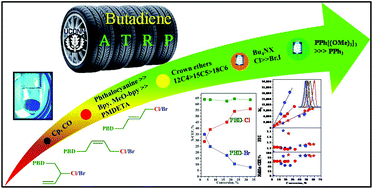Normal, ICAR and photomediated butadiene-ATRP with iron complexes
Abstract
The ligand (L) and halide effects of a series of iron complexes (FeX2 or FeX3, X = Cl, Br)/L supported by carbon (Cp2Fe2(I)(CO)4 > Cp2Fe > Fe(CO)5 > (Ph2PCp)2Fe), nitrogen (phthalocyanine ≫ bpy ≥ MeO-bpy ≫ PMDETA > phen), halide (FeXmY4−m/Bu4N, X, Y = Cl ≫ Br > I), oxygen (12-crown-4 ≫ 15-crown-5 ≥ dibenzo-18-crown-6) and phosphorous (P[Ph(2,4,6-OMe)3]3 > P(t-Bu)3 ≫ P(n-Bu)3, PPh3, P[Ph(4-CF3)]3, P(C6F5)3) ligands, as well as ligand-free FeX3, were evaluated in the normal, ICAR, and photo-ATRP of butadiene (BD) initiated from bromoesters, α,α-dichloro-p-xylene, or FeX3 in toluene at 110 °C. Good polymerization control was observed in many cases, and two clear trends i.e. P[Ph(OMe)3]3 ≫ Bu4NX > crown ethers > amines > C-ligands and FeCl2, FeCl3 ≫ FeBr2, FeBr3 occur consistently across all polymerizations. These effects correlate with the higher stability of the allyl PBD-Cl vs. PBD-Br chain ends and with FeCl3 likely being a better deactivator than FeBr3. Conversely, while basic enough to reduce FeX3, P[Ph(2,4,6-OMe)3]3 is not nucleophilic enough to quaternize PBD-X in the apolar toluene and successfully enables a faster activation/deactivation equilibrium than all other ligands. As such, e.g. N-ATRP with [BD]/[R–Br]/[FeCl3]/P[Ph(2,4,6-OMe)3]3 = 100/1/2/3 affords a linear Mnvs. conversion profile with PDI as low as 1.15–1.2 and a halide chain end functionality (CEF) = 0.65 at up to 50% conversion. While controlled polymerizations occur in photo-ATRP even without ligand and initiator, photoirradiation of catalytic N-ATRP with BD/R–Br/FeCl3/P[Ph(2,4,6-OMe)3]3 = 100/1/0.05/0.15 significantly improves the rate (×10 vs. dark), conversion (up to 70%) and X-CEF (0.9) via the additional initiation afforded by FeX3 photolysis, albeit with a slight PDI increase to ∼1.4. Thus, Fe-mediated BD-ATRP is achievable, and the rational selection of the polymerization variables enables minimization of side reactions and the successful synthesis of well-defined PBD with a wide range of molecular weights, narrow PDI and reasonably high X-CEF, suitable for the preparation of e.g. block copolymers.

- This article is part of the themed collection: Frontiers in Supramolecular and Macromolecular Science symposia


 Please wait while we load your content...
Please wait while we load your content...